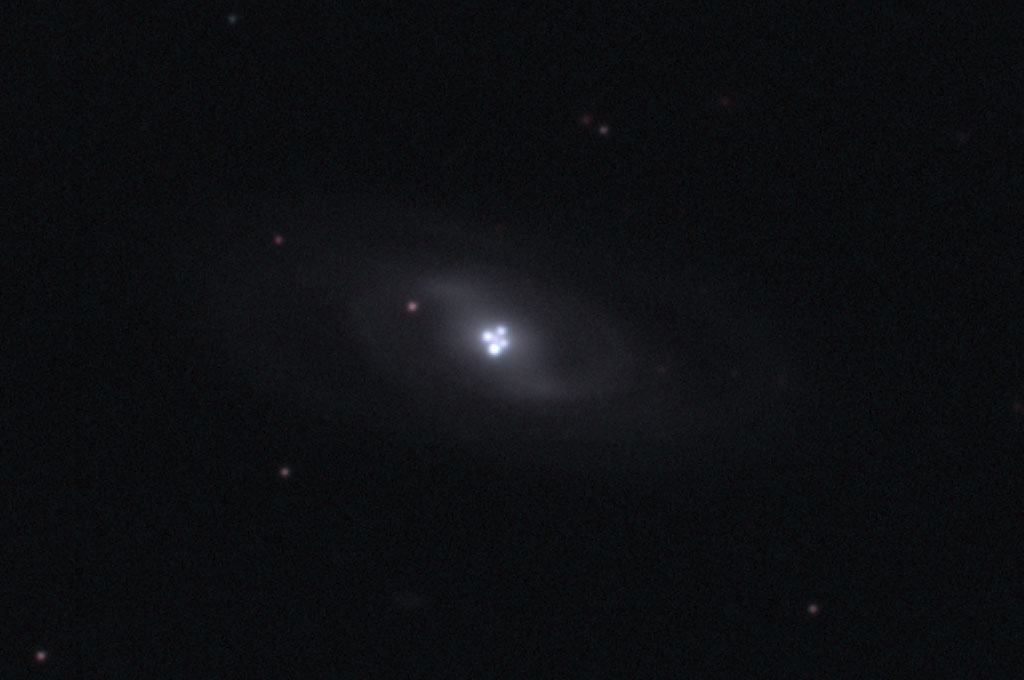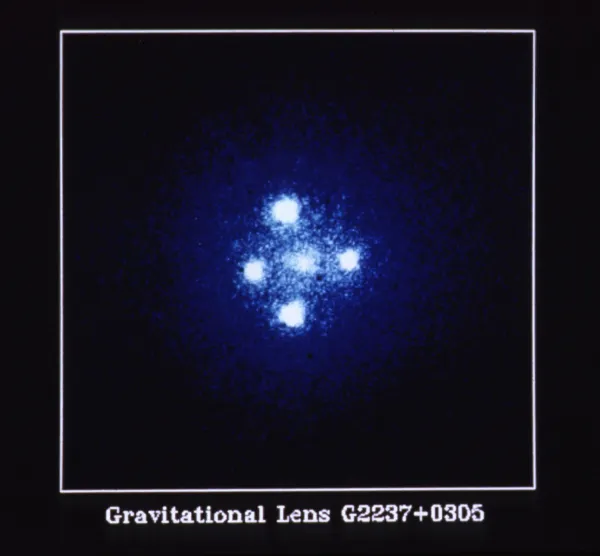Einstein Cross (QSO J2240+0321)

History
The spiral galaxy Z 378-15 (Z 2237.9+0305, CGCG 378-15, PGC 69457, LEDA 69457) first appeared in «Catalogue of galaxies and of clusters of galaxies» by Fritz Zwickys et al. which was published in 8 volumes from 1961 to 1968. [688]
In 1984 John Huchra et al. have discovered a gravitational lens which consists of a quasar nearly centred on the spiral galaxy. At 2" resolution, only a single optical image of the quasar was visible. [689] In 1986 at least two images of the lensed quasar could be identified. 1988 all three quasar images could be photographed using the 3.5m Canada-France-Hawaii telescope on Mauna Kea, Hawaii. [690]
The quasar is known referrad as QSO J2240+0321 (its J2000.0 position), QSO B2237+0305 or Q2237+0305 (its B1950.0 position), G 2237+0305 (G for gravitational lens), «Huchra's Lens» after its discoverer or «Einstein Cross» because it is an excellent example for gravitational lensing, postulated by Albert Einstein.

Physical Properties
QSO J2240+0321 is a gravitationally lensed quasar which lies behind the nucleus of the spiral galaxy Z 378-15. The mass of the much closer galaxy (z = 0.0386, approximately 400 million light years) is bending the light, causing a lens-like effect resulting in 4 distinct images of the same more distant quasar at z = 1.695 (distance approximately 8 billion light-years). The four images have an angular separation of 1.6 arcseconds and undergo colour and brightness variations with a time scale of only a day or so. [687]
| Name | Type | RA (J2000.0) | Dec (J2000.0) | Rvel [km/s] | z | M Type | Size ['] | Magnitudes | Identifiers |
|---|---|---|---|---|---|---|---|---|---|
| QSO J2240+0321 | QSO | 22h 40m 30s | +03° 21' 31" | 227230 | 1.695 | BWSH C; KODIAQ J224030+032130; LAMOST J224030.22+032130.3; NAME Einstein Cross; NAME Huchra's Lens; QSO B2237+030; QSO B2237+0305; QSO J2240+0321; [HB93] 2237+030; [HVG99b] 22379+0305; [VV2000] J224030.3+032130; [VV2003] J224030.3+032130; [VV2006] J224030.3+032130; [VV2010] J224030.3+032130; [VV96] J224030.3+032130; [VV98] J224030.3+032130; [WBS99] 1; [Y88] G | |||
| Z 378-15 | AGN | 22h 40m 30s | +03° 21' 31" | 11352 | 0.0386100001633 | Sab | 0.955263 × 0.449451 | J 12.214; H 11.646; K 11.2; g 15.0426; r 14.2242; z 13.5966 | 2MASX J22403023+0321306; AGC 320302; LEDA 69457; NPM1G +03.0590; UZC J224030.2+032131; Z 2237.9+0305; Z 378-15; [HSN2016] J340.12+03.35 |
Finder Chart
The galaxy Z 378-15 (PGC 69457) with the Quasar QSO J2240+0321 is located in the constellation Pegasus. It is in opposition to the sun on 1 September and can best be observed in the months of May to February.
Visual Observation
762 mm Aperture: The Einstein Cross, or the quasar QSO J2240+0321, appears slightly square-shaped, with its form constantly changing due to atmospheric turbulence. While individual points do flash, their location and identity cannot be determined. No single light points are clearly identifiable; instead, multiple light sources are spread out over an area. The host galaxy PGC 69457 appears faintly extended at medium magnification. — 30" f/3.3 SlipStream Dobsonian, Hasliberg, 20. 11. 2011, SQM 21.27, Eduard von Bergen
